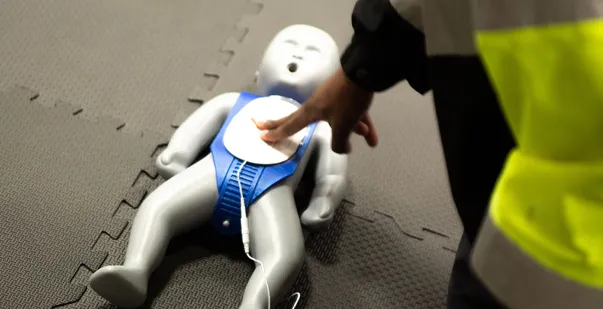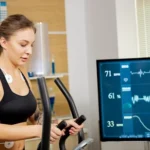Table of Contents
- Introduction
- Importance of AEDs in Emergencies
- Common Causes of Cardiac Arrest in Young Patients
- Symptoms of Cardiac Arrest in Infants and Children
- AED Technology and Pediatric Use
- Steps to Use AEDs in Children and Infants
- Correct Approach If Pediatric Pads are Unavailable
- Safety Considerations for AED Use in Children and Infants
- Risks for Children and Infants
- Training of Caregivers For Using AEDs in Children and Infants
- Final Thoughts
AEDs are lifesaving devices for treatment during a cardiac arrest. However, for children from age birth to infancy, there are vital differences to be understood in treatment. For children below 8 years or weighing less than 55 pounds, pediatric pads should be applied if available.
The pads are smaller and deliver a lower-energy shock that a child’s body can accommodate. However, placing the pads on infants is different from placing them on others. This article discusses the use of AEDs in children and infants, including proper usage and correct AED pad placement for infants.
Importance of AEDs in Emergencies
When the heart suddenly stops, every second counts. AEDs play an important role in increasing the life expectancy of individuals who develop SCA. Here are some of the main reasons why an AED is essential in an emergency:
- Instant Interventions: AEDs allow immediate intervention during cardiac arrest. The sooner the shock is administered, the better the chances of survival.
- User-Friendly Design: AEDs are designed to be user-friendly. They come with clear instructions to guide users through the defibrillation process. Even individuals with minimal training can effectively use an AED to save lives.
- Availability: AEDs are most common in public places, such as schools, airports, and shopping malls. Easy access to AEDs can be helpful in a cardiac emergency.
- Increased Survival: The use of an AED within the first few minutes of cardiac arrest can increase the chances of survival. Every minute without defibrillation reduces survival, emphasizing the importance of early intervention.
Common Causes of Cardiac Arrest in Young Patients
The problem has become serious in the last few decades. Let’s examine the major causes of cardiac arrest in children and infants.
Congenital Heart Defects
Congenital heart defects affect the structure and function of the heart. These defects can prevent normal blood flow through the heart, increasing the risk of cardiac arrest. Some common congenital heart defects that can cause heart failure in children and infants include:
- Atrial septal defect
- Ventricular septal defect
- Tetralogy of Fallot
- Hypoplastic left heart syndrome
Drowning in Water
When a child or infant gets submerged in water, there is a lack of oxygen, which can lead to premature cardiac arrest. It is important to be vigilant about water bodies and ensure adequate safety measures are in place to prevent drowning.
Trauma
Trauma, such as severe chest injury, can cause cardiac arrest in kids. Blunt force trauma or a sudden blow to the chest can damage the heart’s electrical system. It can also cause abnormal heart rhythm and lead to cardiac arrest. Prompt medical treatment is important in these cases to prevent further complications.
Symptoms of Cardiac Arrest in Infants and Children
Parents, caregivers, and healthcare professionals must recognize the signs of cardiac arrest in young infants. Some common symptoms are:
- A sudden loss of consciousness
- No responsiveness
- Absence of Normal breathing
- Bluish Discoloration of the skin
- Unexplained seizures or convulsions
If you suspect a child or infant is having a heart attack, act quickly and seek urgent medical help. Emergency interventions, such as cardiopulmonary resuscitation (CPR) and defibrillation, can greatly improve the chances of survival.
AED Technology and Pediatric Use
Automated external defibrillators (AEDs) have become an important life-saving tool in sudden cardiac emergencies. These portable devices deliver electricity to the heart to restore its normal rhythm. Although AEDs are commonly used in adults, it is important to consider their feasibility and safety in pediatric patients.
AED Functions
They’re equipped with advanced technology that analyzes heart rhythms during cardiac arrest. Once a shock sound is detected, the AED prompts the user to deliver a shock by pressing a button.
The device will then deliver the appropriate amount of electricity to the heart in an attempt to restore normal heart rhythm. AED is user-friendly, with voice control and clear instructions to guide even untrained individuals through the rescue process.
When to Use Pediatric AED Pads
Knowing when to use pediatric AED pads comes into play with the process of responding to an emergency. Generally, you would use pediatric AED pads for children who are:
- Under 8 years of age
- Weigh less than 55 pounds (25 kg).
Be aware that these are general guidelines. It is always advisable to follow the instructions given by your AED device since different manufacturers may vary slightly in their recommendations so that you understand how you would use pediatric AED pads for which children.
Pediatric Pads vs. Adult Pads
The shock delivered for defibrillation is lower for infants than for adults, as the child’s smaller body requires less electrical energy, around 50 joules, to reestablish a normal heartbeat. The second distinction is that pediatric AED pads should be available; they are designed to fit the smaller body size of children. These pads are not only smaller but also placed differently to ensure the effective delivery of the shock.
Some advanced AEDs now incorporate age-specific algorithms that analyze pediatric heart rhythms more appropriately. Such algorithms are modified according to the unique characteristics of children’s cardiac rhythms.
Are you still wondering where pediatric AED pads are placed on an infant? Always follow the anterior-posterior placement as described above. This AED placement on infant patients maximizes the effectiveness of the shock while minimizing potential risks.
Steps to Use AEDs in Children and Infants
Knowing how to use an Automated External Defibrillator (AED) on children and babies can save lives. Here are the steps to follow when using AED pads on infants.
-
Assessment of the Situation
The first step is to assess the situation and ensure the location is safe. Watch for any hazards that could harm you or your child. You will also need to ensure the child sleeps on a flat, waterproof surface.
-
Checking Responsiveness and Breathing
In the next step, you will have to gently tap the child’s response and ask if they are okay. If the child does not respond, test for normal breathing. Keep your ear close to your baby’s mouth and nose to listen and feel for breathing.
-
Turn On the AED and Follow the Prompts
After calling for help, turn on the AED and follow the voice prompts. The AED will give you clear instructions on what to do next. Listen carefully and follow the prompts. Make sure you use a manual defibrillator for infants correctly, not meant for adults.
-
Proper Pad Placement
What is a correct approach for AED pad placement for infants? The correct approach for AED pad placement for infants is as follows:
- One pad should be placed on the center of the infant’s chest, between the nipples.
- The other pad should be placed on the infant’s back, between the shoulder blades.
Correct Approach If Pediatric Pads are Unavailable
In an emergency situation, you might find yourself without pediatric pads. If pediatric pads are unavailable, it is acceptable to use adult pads on a child or infant. Here’s what you should do:
- Use adult pads, but ensure they do not touch or overlap.
- When placing pediatric AED pads on an infant, use the anterior-posterior method, with one pad on the chest and one on the back.
- If the child is large enough, you can use the standard adult placement (upper right chest and lower left side).
Remember, using adult pads on a child or infant is better than not using an AED at all in a cardiac emergency.
Safety Considerations for AED Use in Children and Infants
When it comes to first aid in an emergency, AEDs play a key role in saving lives. However, you must follow specific safety considerations for infant AED pad placement. Follow these safety parameters:
-
Ensure a Safe Environment
Check for hazards such as water, metal surfaces, or wet soil that could harm the child or infant while applying the AED. Additionally, make sure the area is clear to anyone to prevent interruptions.
Creating a safe environment also includes removing any clothing or jewelry that could interfere with AED pad placement. Follow the AED manufacturer’s instructions carefully for AED placement on infants.
-
Avoid Contact During Shock Delivery
An important safety consideration when using AEDs in children and infants is to avoid contact with the child during shock delivery. It is important to ensure that no one around you touches a child or infant while an AED is administering shock. This should not pass through anyone else other than the intended recipient of the electricity, as it may hamper the problem.
Risks for Children and Infants
Although AEDs are generally safe and effective for the treatment of sudden cardiac arrest in children and infants, there are risks and contraindications to consider. When treating young patients with AEDs, you must use a pediatric AED.
In addition, some medical conditions or factors may contraindicate the use of AEDs in children and infants. These include congenital heart defects, certain medications, or past events that caused the heart to stop suddenly. If there is any doubt about the appropriateness of an AED in a child or infant, consult with emergency personnel or a physician.
Training of Caregivers For Using AEDs in Children and Infants
Today, accidents can happen at any time. In such cases, Parents, teachers, caregivers, or family members play an important role in ensuring the safety of young ones. An important part of preparation is knowing how to use an external defibrillator (AED).
-
CPR and AED Training For Caregivers
CPR and AED training provide the skills necessary to respond in an emergency. CPR helps keep blood flowing to vital organs until professional help arrives. An AED can deliver life-saving shocks to restore normal heart function.
Being prepared for CPR and AED training can help a child or an infant during critical situations. Additionally, developing the skills to perform CPR and operate an AED gives caregivers relief, knowing they’re ready to act in an emergency.
-
Resources For Training
Various resources are available to caregivers. Many hospitals, community centers, and schools offer Basic Life Support courses, including CPR and AED training. These classes are conducted by certified instructors who provide hands-on training with CPR manikins and AED instructors.
In addition to in-person training, online courses are available for caregivers who want to learn at their own pace. Online CPR and AED courses often include interactive modules, videos, and quizzes.
-
Regular Checking and Maintenance of AEDs
Once caregivers have completed CPR and AED training, it is important to ensure their AEDs are properly maintained and ready to use in an emergency. Check their batteries and pads’ expiration dates. Also, look for wear and tear on the machine.
Keep the AEDs in easily accessible places so you can use them quickly when you need them. If pediatric pads are unavailable, a manual defibrillator infant is advisable.
Final Thoughts
Though the thought of using an AED on a child or infant may sound a bit overwhelming, these machines are meant to be user-friendly and really do increase survival chances in cases of cardiac arrest. Proper training and frequent practice, with an understanding of the guidelines, should give you confidence that will enable you to act quickly and effectively during an emergency.
As technology continues to improve, we might expect even more user-friendly and adaptable AEDs in the future. Still, the fundamentals of rapid action, correct pad placing, and following the prompts on the AED will remain constant in saving lives across all age groups. So, learn the correct approach for AED pad placement infants to avoid issues.






